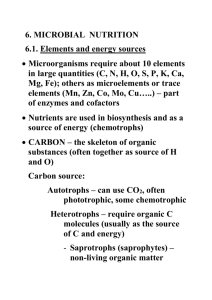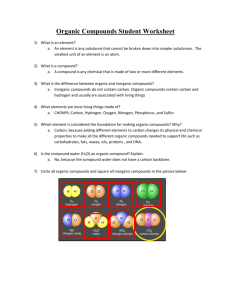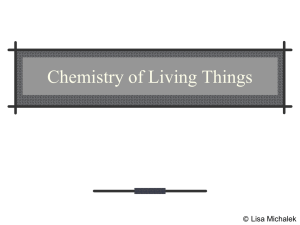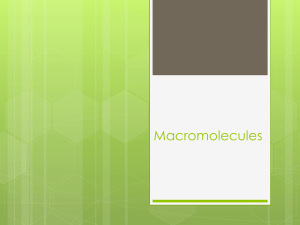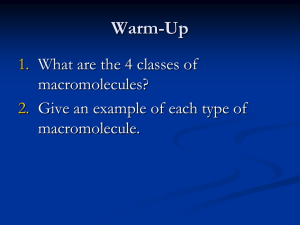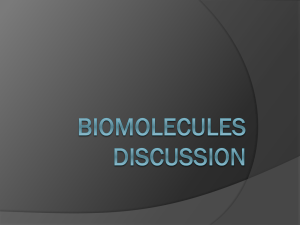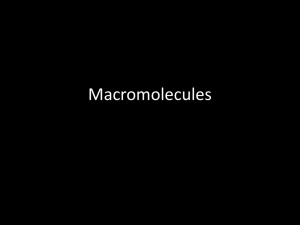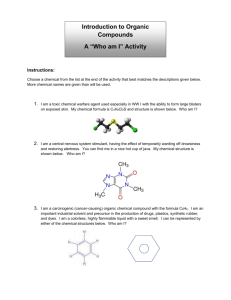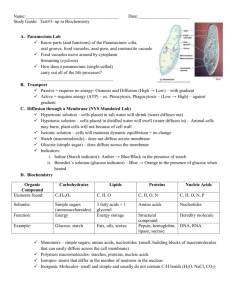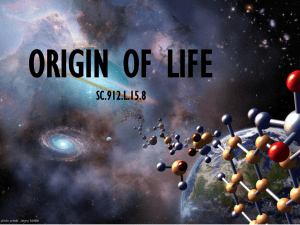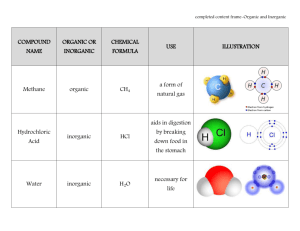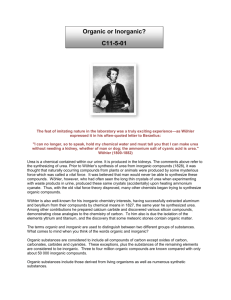Packet 7: Biochemistry
advertisement
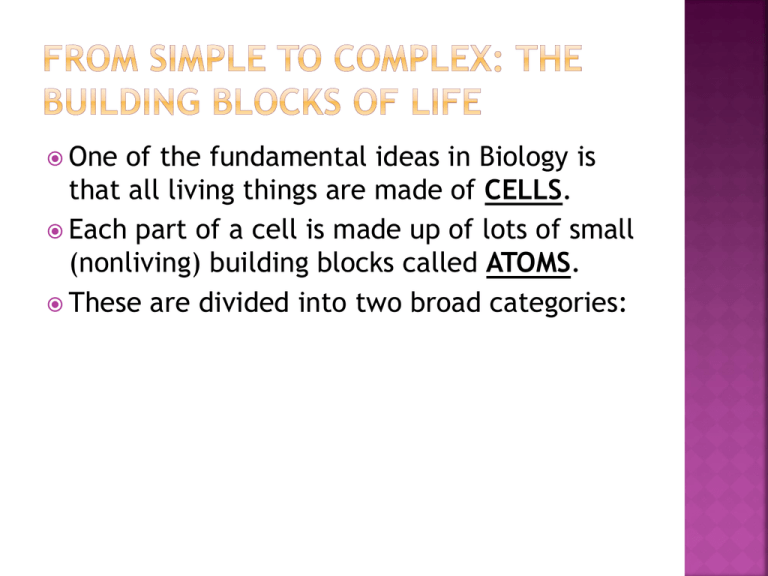
One of the fundamental ideas in Biology is that all living things are made of CELLS. Each part of a cell is made up of lots of small (nonliving) building blocks called ATOMS. These are divided into two broad categories: Organic Compounds- are easy to identify because they must contain the element carbon. Carbon is known as the building block of life because ALL living things contain carbon. Inorganic Compounds- do not contain the element carbon. Carbon Dioxide (CO2) is the main exception to this rule. It contains Carbon, but is classified as inorganic. PRODUCERS – such as plants are able to make their own organic compounds from inorganic compounds through photosynthesis (the chemical equation is seen below). Carbon Dioxide + Water + 6 CO2 Inorganic Sunlight Glucose + 6 H2O + Solar energy Inorganic + Oxygen C6H12O6 + Organic Inorganic 6 O2 CONSUMERS- such as humans must get the building blocks to grow and survive from the food that we eat (i.e. plants or other animals) Glucose + Oxygen -> Carbon Dioxide +Water + Cell Energy C6H12O6 + 6 O2 6CO2 Organic Inorganic Inorganic + 6 H2O + ATP Inorganic If we know that today, almost all organic compounds are only formed by living things, then the question became – how did the first organic compounds form? Alexander Oparin – A. He hypothesized that in the oxygen free environment (anaerobic) of primitive earth, it would have been possible for inorganic molecules to combine and form organic molecules (abiotically – without a living thing). A. They simulated the conditions thought to be around in early Earth’s atmosphere. B. To do this they sealed several simple (inorganic) gasses plus water in a closed glass chamber. Periodically they ignited a spark (to simulate lightening) C. At the bottom of the collection chamber they found Amino Acids which had formed on their own. The formation of this organic compound supported Oparin’s hypothesis. D. Further research has shown how similar conditions could produce two other important organic compounds that are found in RNA ( part of your genetic code). Miller and Urey’s experiment provides support for the idea that conditions on lifeless, ‘primordial’ Earth could have allowed the spontaneous formation of more complex (organic) molecules Since the conditions on Earth are now very different, we do not see the same reactions occuring. MONOMER: A single compound or building block used to make a larger compound. POLYMER: Many monomers joined together to form a large compound. Polymerization: the process joining compunds together to make large compounds Macromolecules: large molecules made when polymers join together Dehydration Synthesis: The process of combining small compounds to form large compounds and water molecules Hydrolysis: Breaking down a larger compound (polymers) into smaller pieces (monomers)… Enzymes and water are needed to break the polymer down. Carbohydrates Lipids Proteins Nucleic Acids 1. Carbohydrates: Contains the elements carbon, hydrogen and oxygen. Three main functions Provide Energy for body (Glucose: C6H12O6) Food Storage Plays a role in the cell membrane Monosaccharide: ONE simple sugar Ex. Glucose and fructose Disaccharide: TWO monosaccharides bonded together Ex. Sucrose (which is a glucose bonded to a fructose) Polysaccharide (or complex carbodydrates): MANY simple sugars bonded together Ex. Cellulose (which forms the cell wall of plants and gives structural support to plant cells). Animals (mammals) store excess sugar as GLYCOGEN (a polysaccharide) Plants store an excess of sugar (glucose) in the form of STARCH (a polysaccharide). Glucose is the primary product of photosynthesis (the base of our energy source) Also known as fats, oils and waxes. Fats are SOLID at room temperature and come from animals. Oils are LIQUID at room temperature and come from plants. http://player.discoveryeducation.com/index.cfm ?guidAssetId=b257ccd0-1cfc-4007-859763517f1f8560&productCode=HUB Fatty acids and glycerol are the monomers (building blocks) of lipids Both types of monomer are made up of carbon, hydrogen and oxygen atoms A triglyceride is a lipid made up of 3 fatty acids bonded to one GLYCEROL which makes it a polymer. Most lipids are (non-polar) not soluble in water (think about when you mix oil and water) Long term ENERGY storage (more energy per gram than in carbs and proteins) Forms barrier around all cells Chemical MESSENGER (ex. Hormones such as testosterone and estrogen) INSULATION (ex. Blubber on a whale) WATERPROOFING (ex. Cuticle- the waxy layer on the leaves of plants) Contains the element carbon, hydrogen, oxygen and NITROGEN Monomers of proteins are AMINO ACIDS. There are 20 different amino acids. Different combinations of these amino acids are what makes each protein different. Polymers are polypeptide chains (or protein) held together by PEPTIDE bonds. Peptide bonds A.A. A.A. A.A. A.A. A.A. A.A. A.A. A.A. A.A. Structural Component of cell membrane, hair and fingernails Helps chemical reactions occur faster while needing less energy (these types of proteins are known as ENZYMES) Allows for large or charged particles to cross into a cell through the cell membrane Allow for MOVEMENT of the organism i.e. muscles, cilia and flagella The AMINO group, which is NH2 on the left The CARBOXYL group –COOH (sometimes called the acid group) on the right The R group (the only difference between all amino acids is the R group (R is not an element, but rather a symbol that represents the different elements or group of elements that can be put in its place) H H-N Amino Group H C R O C-OH Carboxyl Group Nucleic acids main function is to store cellular information in the form of a code. These codes are important in the manufacturing of proteins for the cells. Composed of carbon, hydrogen, oxygen, nitrogen and phosphorus atoms. Monomers of nucleic acids are called NUCLEOTIDES. Polymers of nucleic acids are DNA and RNA. DNA (DEOXYRIBONUCLEIC Acid) is like the cell’s cookbook. It contains all the instructions (or recipes) that each cell needs to survive. RNA (Ribonucleic Acid) is like a single recipe. The purpose of RNA is to CARRY MESSAGES, such as the instructions for making proteins.



